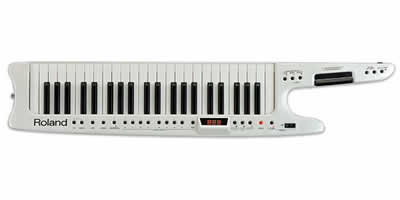Roland AX-7 MIDI Keyboard Controller
Roland Updated: 2009-02-16 RSS
Building on the legendary design of the AX-1, the new AX-7 MIDI Keyboard Controller offers stage performers more freedom and expressiveness. Just strap it on and you're front-of-stage with the band. A host of controllers-including a D-Beam-opens up a new dynamic for live players, while the AX-7's attractive pearl white design looks great on stage. It's also very easy to use, thanks to a new LED display, expanded patch memory and GM2/gs compatibility.
* Stage-oriented shoulder keyboard in attractive pearl white body
* 45-note velocity-sensitive keyboard-perfect for solos and bass lines
* Intuitive operation via new 7-segment LED display
* 5 realtime controllers: Data Entry knob, Touch Controller, Expression Bar, Hold button and light-sensing D-Beam
* 128 patches with data backup via MIDI
* 2 MIDI zones for independent control of Upper/Lower parts
* GM2/gs Compatible
* Battery or AC powered
Free Yourself
Tired of performing behind a stack of keyboards? Then strap on an AX-7 and become mobile without giving up the control you need. Its pearl white body will draw lots of admiring looks, and with 49 velocity-sensitive keys, you can play anything from bass lines to solos and chords—just transpose the keyboard to suit the range needed. Best of all, the AX-7's lightweight design means you'll be comfortable even when playing an all-nighter.
Powerful Control Features
As a controller, the AX-7 offers many of the same features found in Roland's newest keyboards. Two MIDI zones give you independent control over Upper and Lower parts, while an expanded patch memory allows users to save and instantly recall up to 128 setups in patch memory. And when these memories become full, simply back up the data via MIDI. The AX-7 is also GM2/GS-compatible, making it extremely easy to control many of today's synthesizers and sound modules.
New LED Display, D-Beam and More
With its new 3-digit LED display, the AX-7 easily eclipses its predecessor's user interface. Performers will also appreciate the wealth of realtime control available, from the traditional Touch Controller (for pitch) and Expression Bar to the new light-sensing D-Beam. Using the D-Beam, you can control anything from chord memory to arpeggios and expression data via an infrared beam of light.
Owners Manual
TurboStart
Related Manuals
Roland AT-90S Atelier Organ
Roland C-190 Portable Classical Organ
Roland C-280 Classic Organ
Roland C-80-AK Digital Harpsichord
Roland DB-900 D-Bass Amplifier
Roland DisCover 5 RealTime Orchestrator
Roland DP-900 Designer Piano
Roland E-100 Intelligent Keyboard
Roland E-200 Intelligent Keyboard
Roland EM-15 Creative Keyboard
Roland EM-2000 Creative Keyboard
Roland EM-25 Creative Keyboard